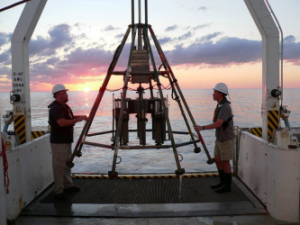
Researchers prepare to deploy a multi-corer which will collect sediment samples from the sea floor. Photo: USM
Initially, much of the oil released from the Macondo well during the Deepwater Horizon disaster floated on the surface of the water. Over time, physical processes drove some of the oil onto beaches and into other shallow habitats of the northern Gulf of Mexico. Researchers from the University of Southern Mississippi are trying to determine where the rest of the oil went. They want to see if oil has also reached the sea floor at greater depths, and if so, where.
Classroom Activity: Deep-Sea Sediments
The ocean floor is made up of sediment including sand, silt and clay particles. The skeletons of tiny animals also contribute to deep-sea sediments. The particles take different amounts of time to reach the sea floor, depending on their density and size. Scientists study the layers of particles to create a historical record of the ocean floor. In this lesson, students will examine a core sample and conduct an experiment to see what factors influence settling rates.
Responses of Benthic Communities to Oil Exposure – PDF 1.1MB
